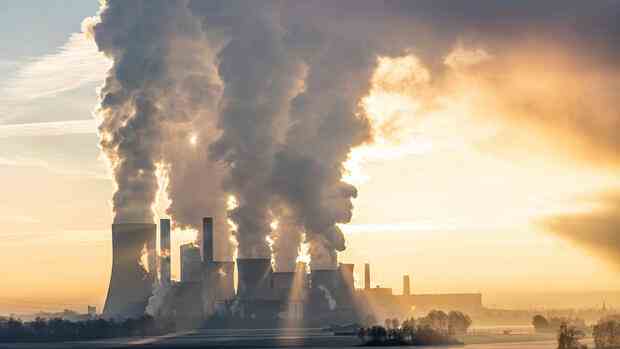The authors of the position paper consider the development of a CO2 transport and storage infrastructure in Germany and Europe to be crucial.
(Photo: IMAGO/Wienold)
Berlin The cement and chemical industries, as well as other sectors, are joining forces with the climate protection organizations Germanwatch and Bellona. Together they are promoting rapid progress in CO2 storage to the federal government.
In a joint position paper, which is available to the Handelsblatt, they are in favor of fundamentally reforming the existing legal framework and enabling large-scale CO2 storage. To do this, “all nationally available options would have to be considered”, including the “storage potential in the North Sea”.
Although storage in Germany under the sea floor is generally permissible under the current legal situation, it is limited to pilot projects with quantity restrictions. Now the commercial application must also be made possible, according to the demand.
Martin Schneider, General Manager of the German Cement Works Association (VDZ), said there was little time to make progress with CO2 storage: “If we want to be climate-neutral by 2045, the first projects for capturing, transporting, storing and using CO2 still have to be carried out go into operation in 2030.”
Top jobs of the day
Find the best jobs now and
be notified by email.
His industry is one of those industries in which process-related CO2 emissions occur that cannot be avoided. The Federal Environment Agency puts the unavoidable CO2 emissions from industry and waste and wastewater management in Germany at 43 million tons a year. A total of 739 million tons of greenhouse gases were released in Germany in 2020.
Evaluation report must be submitted every four years
In principle, the Federal Government is prepared to accelerate and expand the use of the controversial technology of underground CO2 injection in order to achieve the climate goals: CO2 storage (Carbon Capture and Storage, or CCS for short) and also the use of captured CO2 must be phased out as early as 2030 CO2 (Carbon Capture and Utilization, CCU for short) “on the megaton scale” can be used primarily for industry. This is what it says in the “Evaluation report on the carbon dioxide storage law” of the Federal Ministry of Economics, which became public at the beginning of December. It is to be decided by the federal cabinet on Wednesday.
CO2 is to be separated and stored on a large scale.
(Photo: REUTERS)
The evaluation report must be submitted every four years. It forms a basis for the “Carbon Management Strategy” that the federal government intends to develop next year. In the coming weeks and months it will therefore be a question of defining the framework for CCS and CCU.
The authors of the position paper consider the development of a CO2 transport and storage infrastructure in Germany and Europe to be crucial. Schneider says the carbon management strategy must set guidelines for the CO2 infrastructure. “Right now, companies need a clear perspective that their upcoming investments in CO2 capture will be politically flanked by a corresponding framework for the transport, use and storage of CO2.”
>> Read here: America’s dream of the CO2 vacuum cleaner – How an oil company’s plant could save the climate
One of the core demands is to enable CO2 transport across national borders. That’s out of the question at the moment. The reason for this is the London Protocol, a global agreement for the protection of the marine environment. Under Article 6, Parties are not permitted to export waste or other materials for landfill or incineration at sea.
Signs for CCS criticism have changed
CCS and CCU value chains are not yet economically viable at the moment. The authors of the position paper therefore call for differential contracts for the operating and investment costs.
Scholz inaugurates the first LNG terminal on the North Sea coast
They are concluded between the public sector and individual companies. On the basis of the contracts, companies are compensated for the additional costs they incur through the construction and operation of more climate-friendly systems compared to conventional systems.
The Carbon Dioxide Storage Act (KSpG) came into force in Germany in 2012. However, it restricts the technology to demonstration and pilot projects and significantly limits the permissible storage volume. In addition, the federal states have the option of excluding CO2 storage for their country.
>> Read here: CO2 removal from the air – EU Commission proposes legislation for a certificate system
The bottom line is that the law prevents CCS technology in Germany. However, the signs have changed. A decade ago, the critics of CCS technology still argued that CCS primarily serves the purpose of giving coal-fired power plants a chance of survival. However, with the statutory phase-out of coal, this argument no longer applies.
CCS has been tried and tested worldwide, and Norway is a pioneer in large-scale application. But there are also larger projects in the Netherlands, Denmark and Great Britain.
More: Millions of tons of CO2 underground – Habeck opens the door to greenhouse gas storage
